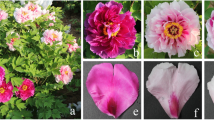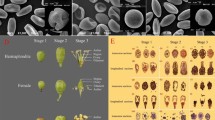Abstract
The lack of sexual processes prohibits genetic studies and conventional breeding in commercial cultivars of garlic. Recent restoration of garlic flowering ability by environmental manipulations has opened new avenues for physiological and genetic studies. The LEAFY homologue gaLFY has been shown to be involved in the floral development, while two alternatively spliced gaLFY transcripts are expressed in flowering genotypes. In the present work, quantitative real-time PCR and two techniques of RNA in situ hybridization were employed to analyze spatiotemporal expression patterns of the gaLFY during consequent stages of the garlic reproductive process. Temporal accumulation of gaLFY is strongly associated with reproductive organs, significantly increased during florogenesis and gametogenesis, and is down-regulated in the vegetative meristems and topsets in the inflorescence. The two alternative transcripts of the gene show different expression patterns: a high level of the long gaLFY transcript coincided only with floral transition, while further up-regulation of this gene in the reproductive organs is associated mainly with the short gaLFY transcript. It is concluded that gaLFY is involved at different stages of the sexual reproduction of garlic. These new insights broaden our basic understanding of flower biology of garlic and help to establish conventional and molecular breeding systems for this important crop.






Similar content being viewed by others
References
Albert VA, Oppenheimer DG, Lindqvist C (2002) Pleiotropy, redundancy and the evolution of flowers. Trends Plant Sci 7:289–301
Amasino R (2010) Seasonal and developmental timing of flowering. Plant J 61:1001–1013
Benlloch R, Berbel A, Serrano-Mislata A, Madueño F (2007) Floral initiation and inflorescence architecture: a comparative view. Ann Bot 100:659–676
Benschop M, Kamenetsky R, Le Nard M, Okubo H, De Hertogh AA (2010) The global flower bulb industry: production, utilization, research. Hort Rev 36:1–115
Bernier G, Perilleux C (2005) A physiological overview of the genetics of flowering time control. Plant Biotech J 3:3–16
Blázquez MA, Weigel D (2000) Integration of floral inductive signals in Arabidopsis. Nature 404:889–892
Cockram J, Jones H, Leigh FJ, O’Sullivan D, Powell W, Laurie DA, Greenland AJ (2007) Control of flowering time in temperate cereals: genes, domestication, and sustainable productivity. J Exp Bot 58:231–1244
Coen ES, Romero JM, Doyle S, Elliot R, Murphy G, Carpenter R (1990) Floricaula: a homeotic gene required for flower development in Antirrhinum majus. Cell 63:1311–1322
Etoh T (1985) Studies on the sterility in garlic, Allium sativum L. Memoirs of the Faculty of Agriculture, Kagoshima University, vol 21. pp 77–132
Etoh T, Simon PW (2002) Diversity, fertility and seed production of garlic. In: Rabinowitch HD, Currah L (eds) Allium crop sciences: recent advances. CAB International, Wallingford, pp 101–117
Gocal GF, King RW, Blundell CA, Schwartz OM, Andersen CH, Weigel D (2001) Evolution of floral meristem identity genes: analysis of Lolium temulentum genes related to APETALA1 and LEAFY of Arabidopsis. Plant Physiol 125:1788–1801
Gottlieb Y, Ghanim M, Chiel E, Gerling D, Portnoy V, Steinberg S, Tzuri G, Horowitz AR, Belausov E, Mozes-Daube N, Kontsedalov S, Gershon M, Gal S, Katzir N, Zchori-Fein E (2006) Identification and localization of a Rickettsia sp. in Bemisia tabaci (Homoptera: Aleyrodidae). Appl Environ Microbiol 72:3646–3652
Jenderek MM, Hannan RM (2004) Variation in reproductive characteristics and seed production in the USDA garlic germplasm collection. HortScience 39:485–488
Jenderek MM, Zewdie Y (2005) Within- and between-family variability for important bulb and plant traits among sexually derived progenies of garlic. HortScience 40:1234–1236
Johansen DA (1940) Plant microtechnique. McGraw-Hill, New York
Kamenetsky R (2007) Garlic: Botany and Horticulture. Hort Rev 33:123–172
Kamenetsky R, Rabinowitch HD (2001) Floral development in bolting garlic. Sex Plant Reprod 13:235–241
Kamenetsky R, Rabinowitch HD (2002) Florogenesis. In: Rabinowitch HD, Currah L (eds) Allium crop sciences: recent advances. CAB International, Wallingford, pp 31–58
Kamenetsky R, London Shafir I, Baizerman M, Khassanov F, Kik C, Rabinowitch HD (2004a) Garlic (Allium sativum L.) and its wild relatives from Central Asia: evaluation for fertility potential. Acta Hort 637:83–91
Kamenetsky R, London Shafir I, Zemah H, Barzilay A, Rabinowitch HD (2004b) Environmental control of garlic growth and florogenesis. J Am Soc Hort Sci 129:144–151
Kamenetsky R, London Shafir I, Khassanov F, Kik C, van Heusden AW, Vrielink-van Ginkel M, Burger-Meijer K, Auger J, Arnault I, Rabinowitch HD (2005) Diversity in fertility potential and organo-sulphur compounds among garlics from Central Asia. Biodivers Conserv 14:281–295
Krizek BA, Fletcher JC (2005) Molecular mechanisms of flower development: an armchair guide. Nat Rev Genet 6:688–698
Kyozuka J, Konishi S, Nemoto K, Izawa T, Shimamoto K (1998) Down-regulation of RFL, the FLO/LFY homolog of rice, accompanied with panicle branch initiation. Proc Natl Acad Sci 95:1979–1982
Lamb RS, Hill TA, Tan OK, Irish VF (2002) Regulation of APETALA3 floral homeotic gene expression by meristem identity genes. Development 129:2079–2086
Meng Q, Zhang C, Huang F, Gai J, Yu D (2007) Molecular cloning and characterization of a LEAFY-like gene highly expressed in developing soybean seeds. Seed Sci Res 17:297–302
Molinero-Rosales N, Jamilena M, Zurita S, Gomez P, Capel J, Lozano R (1999) FALSIFLORA, the tomato orthologue of FLORICAULA and LEAFY, controls flowering time and floral meristem identity. Plant J 20:685–693
Moon J, Lee H, Kim M, Lee I (2005) Analysis of flowering pathway integrators in Arabidopsis. Plant Cell Physiol 46:292–299
Mouradov A, Glassick T, Hamdorf B, Murphy L, Fowler B, Marla S, Teasdale RD (1998) NEEDLY, a Pinus radiate ortholog of FLORICAULA/LEAFY genes, expressed in both reproductive and vegetative meristems. Proc Natl Acad Sci 95:6537–6542
Mouradov A, Cremer F, Coupland G (2002) Control of flowering time: interacting pathways as a basis for diversity. Plant Cell 14:S111–S130
Moyroud E, Kusters E, Monniaux M, Koes R, Parcy F (2010) LEAFY blossoms. Trends Plant Sci 15:346–352
Nilsson O, Lee I, Blazquez MA, Weigel D (1998) Flowering-time genes modulate the response to LEAFY activity. Genetics 150:403–410
Noy-Porat T, Kamenetsky R, Eshel A, Flaishman MA (2010) Temporal and spatial expression patterns of the LEAFY homologue NLF during florogenesis in Narcissus tazetta. Plant Sci 178:105–113
Oshima S, Nomura K (2008) RsLFY, a LEAFY homologue gene in radish (Raphanus sativus), is continuously expressed in vegetative, reproductive and seed development. Plant Biotechnol 25:579–582
Pfaffl MW (2001) A new mathematical model for relative quantification in real-time RT-PCR. Nucleic Acids Res 29:e45
Pfaffl MW, Horgan GW, Dempfle L (2002) Relative expression software tool (REST©) for group-wise comparison and statistical analysis of relative expression results in real-time PCR. Nucleic Acids Res 30:e36
Ratcliffe OJ (1999) Separation of shoot and floral identity in Arabidopsis. Development 126:1109–1120
Rotem N, Shemesh E, Peretz Y, Akad F, Edelbaum O, Rabinowitch HD, Sela I, Kamenetsky R (2007) Reproductive development and phenotypic differences in garlic are associated with expression and splicing of LEAFY homologue gaLFY. J Exp Bot 58:1133–1141
Shemesh E, Scholten O, Rabinowitch HD, Kamenetsky R (2008) Unlocking variability: inherent variation and developmental traits of garlic plants originated from sexual reproduction. Planta 227:1013–1024
Shitsukawa N, Takagishi A, Ikari C, Takumi S, Murai K (2006) WFL, a wheat FLORICAULA/LEAFY ortholog, is associated with spikelet formation as lateral branch of the inflorescence meristem. Genes Genet Syst 81:13–20
Shu GP, Amaral W, Hileman LC, Baum DA (2000) LEAFY and the evolution of rosette flowering in violet cress (Ionopsidium acaule, Brassicaceae). Am J Bot 87:634–641
Souer E, Rebocho AB, Bliek M, Kusters E, de Bruin RAM, Koes R (2008) Patterning of inflorescences and flowers by the F-Box protein DOUBLE TOP and the LEAFY Homolog ABERRANT LEAF AND FLOWER of Petunia. Plant Cell 20:2033–2048
Szymkowiak EJ, Irish VE (2006) JOINTLESS suppresses sympodial identity in inflorescence meristems of tomato. Planta 223:646–658
Tooke F, Ordidge M, Chiurugwi T, Battey N (2005) Mechanisms and function of flower and inflorescence reversion. J Exp Bot 56:2587–2599
Vijayraghavan U, Prasad K, Meyerowitz E (2005) Specification and maintenance of the floral meristem: interactions between positively acting promoters of flowering and negative regulators. Curr Sci 89:1835–1843
Wang CN, Möller M, Cronk QCB (2004) Altered expression of GFLO, the Gesneriaceae homologue of FLORICAULA/LEAFY, is associated with the transition to bulbil formation in Titanotrichum oldhamii. Dev Genes Evol 3:122–127
Weigel D, Alvarez J, Smyth DR, Yanofsky MF, Meyerowitz EM (1992) LEAFY controls floral meristem identity in Arabidopsis. Cell 69:843–859
Zaccai M, Mazor I, Weingarten-Kenan E, Ram A (2008) Vernalization and floral transition in the Madonna lily (Lilium candidum). Abstracts of the Xth international symposium on flower bulbs and herbaceous perennials. Lisse, The Netherlands, p 38
Zeevaart JAD (1985) Perilla. In: Halevy AH (ed) Handbook, CRC of flowering. CRC Press, Raton Boca, pp 239–252
Zik M, Irish VF (2003) Flower development: initiation, differentiation, and diversification. Ann Rev Cell Dev Biol 19:119–140
Acknowledgments
We thank E. Belausov, E. Shemesh and H. Zemach, The Institute of Plant Science, Agricultural Research Organization, The Volcani Center, for their assistance in microscopic observations.
Author information
Authors and Affiliations
Corresponding author
Electronic supplementary material
Below is the link to the electronic supplementary material.
425_2011_1361_MOESM1_ESM.ppt
Fig. S1 Primers and probes designed from the 682-bp fragment of gaLFY, GenBank AY563104. The two gaLFY transcripts, gaLFYl and gaLFYs, are different in 64 nucleotides (Rotem et al. 2007) (PPT 57 kb)
Rights and permissions
About this article
Cite this article
Neta, R., David-Schwartz, R., Peretz, Y. et al. Flower development in garlic: the ups and downs of gaLFY expression. Planta 233, 1063–1072 (2011). https://doi.org/10.1007/s00425-011-1361-8
Received:
Accepted:
Published:
Issue Date:
DOI: https://doi.org/10.1007/s00425-011-1361-8




